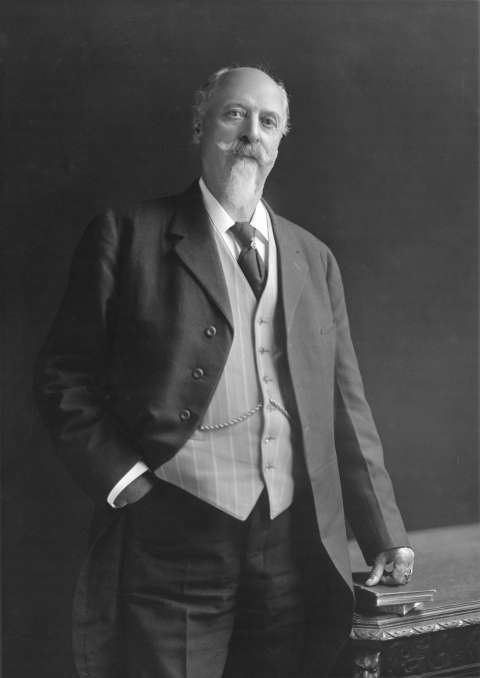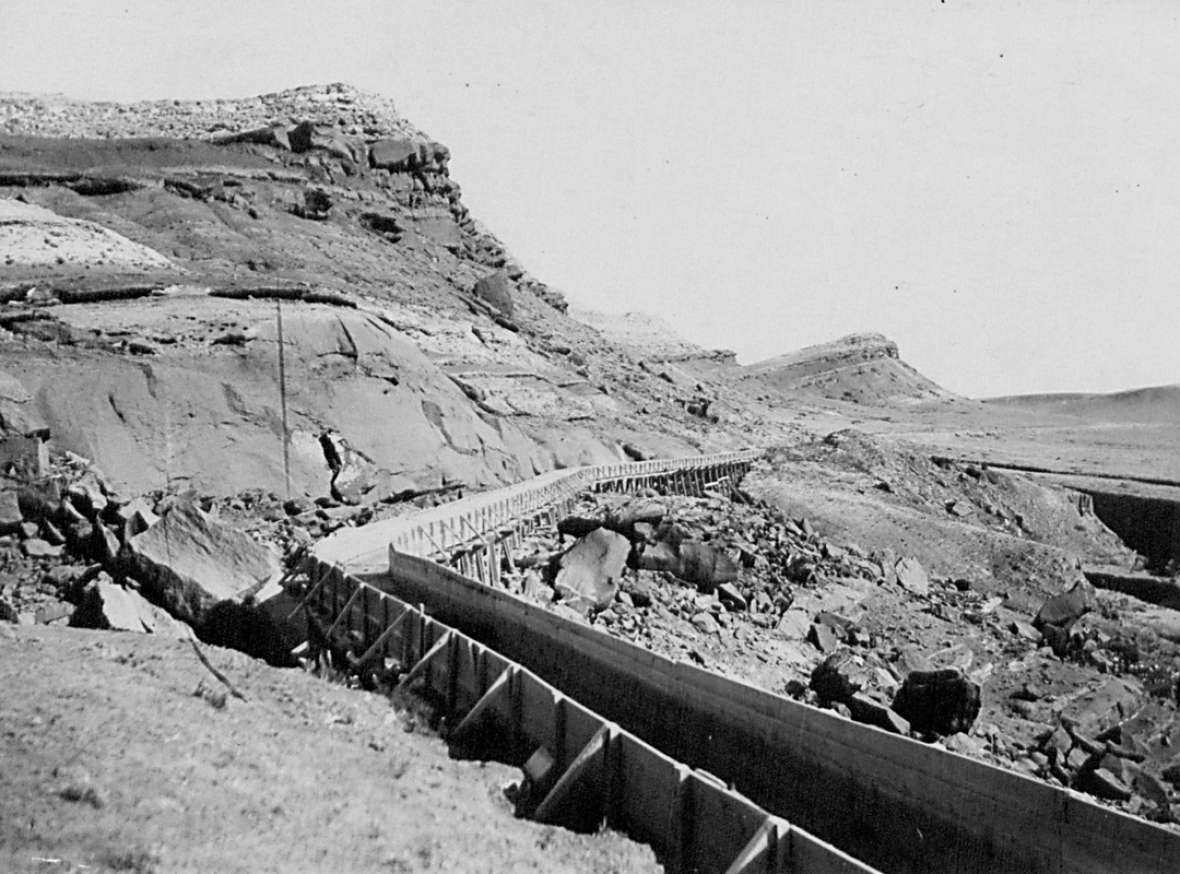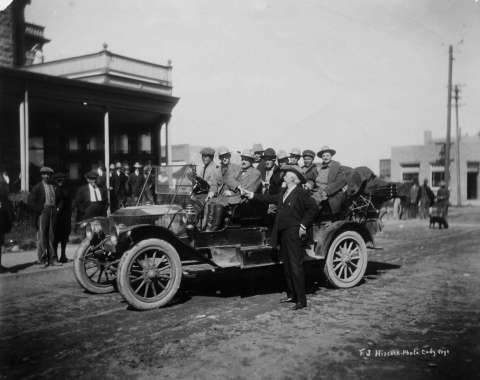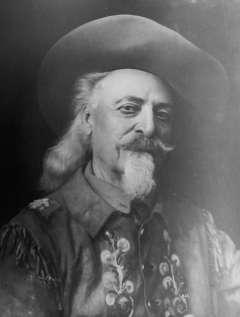- Home
- Encyclopedia
- Town Founder and Irrigation Tycoon: The Buffalo...
Town Founder and Irrigation Tycoon: The Buffalo Bill Nobody Knows
William F. Cody, famous across two continents as Buffalo Bill, leader of the great Wild West show, was flush with cash and bursting with self-confidence when he embarked on his Wyoming life in 1894, promising to build an irrigated empire along the Shoshone River that would be larger than any such enterprise the West had ever seen. In 1916, broke and ill, he slipped out of Wyoming to die the following year in his sister’s home in Denver, still famous and widely mourned, but not the figure he set out to become 22 years earlier. Cody’s life in Wyoming left a wide trail, however, and it was not all downhill.

By the early 1890s it was 20 years since Cody had begun the transformation from scout, to dime-novel hero to full-time showman. By 1894 the Wild West show had toured widely in North America and toured Europe four times, performing twice before Queen Victoria, selling millions of tickets and making Cody a wealthy man.
His extraordinary success with his show at the 1893 Columbian Exposition in Chicago marked the peak of his career as a showman. Now he wanted to make a mark outside the show arena, something that would earn him the enduring respect of wealthy men in the East.
It was water that brought Buffalo Bill into northern Wyoming’s Bighorn Basin. Businessmen George Beck and Horace Alger of Sheridan had purchased a water right to irrigate a large tract along the south side of the Shoshone River where it flows out of the Absaroka Mountains, a hundred miles west of Sheridan. Cody met them in Sheridan in 1893, and they were pleased to bring his name and resources into their project. After Beck and State Engineer Elwood Mead surveyed the land in 1894, and Mead’s report described it as a project that could not fail, they formed the Shoshone Land and Irrigation Company and began digging the Cody Canal in 1895.
Saga of the Shoshone Irrigation Company
From the beginning, the saga of that company, reorganized and renamed Shoshone Irrigation Company in 1896, was a kind of soap opera. Cody knew little or nothing about irrigation or construction, but as company president he tried to micromanage the whole enterprise from his railroad car while he toured America with the Wild West.
As for Beck, he had never undertaken to manage a project this complex. He often found balancing the demands for performance from company directors against the need to conserve scarce funds next to impossible, and chose to say or do nothing rather than get into fights. The land through which they were digging the canal was extraordinarily difficult: In some places it was like cemented gravel, at others it was so sandy the banks would not hold, and they literally had to build a canal of wooden planking above the ground.
Bill Cody had big plans to attract colonies of settlers, all of which fell through. Eastern investors stopped supplying needed capital; only Cody’s willingness to pay far more than his fair share kept the ditch project going at all. By 1897, some water had begun flowing to Cody’s little namesake town they had set up the year before, and the following year they had attracted some more farmers. Violent storms in the summer of 1898 wrecked the canal, however, and led its directors to try to sell out for $150,000, roughly the amount they had put into it. There were no buyers.
Development of water resources in the West was never easy. Westerners argued from 1890 on that only irrigation systems could do the job, and the federal government had to take the lead. The Carey Act of 1894, named after Wyoming U.S. Senator Joseph Carey, was a first attempt. States were each to be given a million acres of public land, and they would contract with private developers to build the water systems.

The Cody Canal was one of the first Carey Act projects in the nation. Watching Carey Act failures all across the West, irrigation advocates realized free land was not enough: The cost of building good irrigation systems was still too great for private resources. Federal intervention would be needed—on a scale beyond anything the government had been willing to consider. In 1902, Congress passed the National Reclamation Act, putting federal money directly into water development for the first time, and the U. S. Reclamation Service was formed to do the job.
When the Burlington Railroad completed its spur line to the town of Cody in 1901, settlement picked up. That was a mixed blessing, however, in that more settlers meant more demand on the canal. The irrigation company’s contract with the state under the Carey Act expired that same year. The directors applied for an extension, but the new state engineer—Elwood Mead having moved on to federal employment—inspected the canal and found it was only half built, and the constructed portion was not reliable. He required them to spend another $43,000 extending and rebuilding the ditch, and two years later his successor returned and required a further $20,000.
The business of the canal was taken over by George Bleistein, a printing magnate and Shoshone Irrigation Company director from Buffalo, N.Y., leaving both Beck and Cody out of it. Company officials found the money and did the work, but it was not enough to keep a group of farmers from taking them to court for failure to provide water. All 26 lawsuits were settled in favor of the plaintiffs, wiping away all possibility of the canal investors recovering their money.
The canal was turned over to the settlers in 1907, and when the cloud of litigation dispersed, the settlers had to sell $95,000 of bonds to raise the money needed to make it irrigate even 12,000 acres reliably. The Shoshone Irrigation Company had spent $282,000 by the end of 1905 to build a canal that could not do its job, and had taken in only $82,000 in water sales to settlers. It was a sorry excuse for an irrigation empire.
The U.S. Reclamation Service
But the Cody Canal was the smaller part of Buffalo Bill’s imperial ambitions. In 1897, amid the chaos and bickering along the Cody Canal, Cody convinced his Wild West partner, Nate Salsbury, to join him in a second irrigation venture.
This one was to carry water to 120,000 acres on the north side of the river, extending more than 25 miles east from Cody. They got their plans approved and the state water right issued in May 1899. Cody and Salsbury knew they would have to raise great sums of money to accomplish this; Buffalo Bill pronounced himself ready to raise a million dollars! That he would take this on at a time when the Cody Canal seemed to be falling apart shows a measure of his ambition and his self-delusion. The partners actually did little real work on this venture.
Capitalists with the kind of money Cody was looking for were not impressed with the chances of this kind of project. When the federal government finally moved decisively into western water development in 1902, officials in the new U.S. Reclamation Service immediately expressed interest in the Cody-Salsbury plan. They wanted to acquire Buffalo Bill’s water right.
The Burlington Railroad, which had built the line to Cody in 1901, wanted to see a federal project on that land; they had no confidence that Cody’s private plans could succeed. Cody temporized throughout 1903, but in early 1904 he finally agreed to relinquish his water right to the Reclamation Service. As a result, the federal government immediately appropriated $2,250,000 to build the Shoshone Project.
They built what was then the highest concrete arch dam in the world in the canyon west of Cody, creating a reservoir of 465,000 acre-feet of water that irrigated 93,000 acres centered on the new town of Powell, 25 miles northeast of Cody. In 1946, on what would have been his hundredth birthday, the dam and the lake were renamed for Buffalo Bill. This honor acknowledged Cody’s vision, while omitting mention of his rather feckless career as an irrigation developer.
Cody’s namesake town
Bill Cody had been better at building a town than an irrigation project. After a stuttering start, with competing layouts two miles apart, the Shoshone Irrigation Company laid out the town of Cody in the spring of 1896. Cody was interested in every detail of the new town: getting a proper hotel built, making sure the streets were wide, recommending that liquor license fees be set high enough to keep the rough trade away.

When they formed the Cody Townsite Company to sell lots, Cody watched it closely. When the Burlington finally came to the deciding point on building into the town, Bill Cody argued in his correspondence constantly and forcefully for the construction. He warned his partners in the townsite company to accommodate the interests of the railroad as expressed through its development arm, the Lincoln Land Company, or risk losing everything they had invested.
The arrival of the Burlington in the fall of 1901 guaranteed that Cody would be a viable town, but it meant that the irrigation company partners had to cede half the income from town lots to the Lincoln Land Company. Buffalo Bill always took credit for getting the railroad to the town. This was clearly overstating the case—the Burlington had good corporate reasons without regard to Bill Cody—but what else would one expect from one of the greatest promoters of his or any other time.
Buffalo Bill owned the livery stable, the blacksmith shop, the newspaper and several ranches around town. He started a company to mine coal outside of town and drilled oil wells. As many as half of the 500 or so people who lived and worked in Cody in 1899 were dependent upon him, and many more applied to him for occasional charity, with which he was famously generous. After the railroad came in, he decided to more than double his financial commitment to the town by building the Irma Hotel—named for his daughter.
Opened with a grand reception Nov. 18, 1902, the Irma—an imposing stone structure in a town of wooden buildings—probably cost him $80,000. No less a judge than the great painter Frederic Remington pronounced it as good a hotel as any in the West. In 1903, a local writer estimated that Cody had poured more than $216,000 into his namesake town. As he fell deeply into debt mining for gold in Arizona, his financial commitment to the town dwindled; he even mortgaged his hotel and his home ranch in that decade and later deeded them to his wife, Louisa, to keep them from being sold by creditors.
But his personal commitment to Cody never wavered. When he returned to Wyoming after the summers of Wild West shows, he always gave a big party at the Irma, when he would speak of his optimism for Cody’s future. No other little town in the West could boast of a cheerleader to compare with Buffalo Bill.

The Irma, “Buffalo Bill’s Hotel in the Rockies,” became the centerpiece of his vision for Cody and the country around it. Cody and Beck marked out a wagon road west from Cody up the North Fork of the Shoshone River to the eastern edge of Yellowstone Park. He built Pahaska Tepee, a hunting lodge, just outside the park, at the end of that road, and the Wapiti Inn halfway between Cody and Pahaska; these became part of the infrastructure of Yellowstone Park tourism, a new industry that the town and the railroad could advertise. He bought a fleet of steam-driven automobiles to carry tourists up and back and lobbied hard in Washington to have a road built from the center of Yellowstone to a new east entrance.
Cody had worked from his very first years in Wyoming to connect his town with the metropolitan East. He organized hunting parties west of Cody in the high Absaroka Mountains every fall when he returned to Wyoming. At first he was hoping to get wealthy men to invest, but later he was more generally determined to make Cody famous among the elite of eastern cities, especially New York.
He joined the Camp-Fire Club in New York, where he could rub shoulders with men who lived to hunt; a few years after he joined the club Cody created an affiliate chapter, one of only four outside of New York. Some Cody men started selling their services as guides and outfitters for eastern hunters, and others began to offer accommodations to tourists who wanted to live on ranches. Cody himself advertised his home ranch, the TE, as a dude ranch in the summer of 1916.
Taken altogether, his creation—for it was nothing less—of the tourist industry in Wyoming was a reverse image of his Wild West show. The Wild West set out to bring the West to the arenas of the East, but the tourist industry grew by bringing more and more Easterners to the West. Cody’s own personality and reputation made for a seamless transition, and to this day the engines of tourism in Wyoming run in no small part on images and memories of Buffalo Bill.
Judged by the standard he set for himself when he came to Wyoming, he must have felt himself something of a failure. He was never marked out by talent or experience to succeed in the irrigation business; there were, in fact, very few notable successes in that line of work anywhere in the West. But everything he had done as a showman led easily and naturally to success in tourism. His townsmen followed where he led, and Cody became a town where the tourist dollar sustains life. Buffalo Bill did not earn great wealth from his tourism ventures, but nearly a century after his death he smiles genially down from large billboards along highways across five states. He literally looms larger than life over the corner of Wyoming that calls itself “Cody Country.”
Resources
- Bonner, Robert E. William F. Cody’s Wyoming Empire; The Buffalo Bill Nobody Knows. Norman, Okla.: University of Oklahoma Press, 2007.
- Cook, Jeannie, et al. Buffalo Bill’s Town in the Rockies; a Pictorial History of Cody, Wyoming. Virginia Beach, Va.: The Donning Company, 1996.
- Warren, Louis S. Buffalo Bill’s America; William Cody and the Wild West Show. New York: Knopf, 2005.
Illustrations
- The photos of Bill Cody the capitalist, Cody with the carload of hunters and the late tourist-promotion portrait are all from the collections of the Buffalo Bill Center of the West in Cody, Wyo., catalog numbers P.69.119, P.6.281and P.6.145, respectively. Used with permission and thanks.
- The 1896 photo of the flume on the Cody Canal is from the George T. Beck papers, Box 31, folder 12, at the American Heritage Center, University of Wyoming, Laramie, Wyo. Used with permission and thanks.
